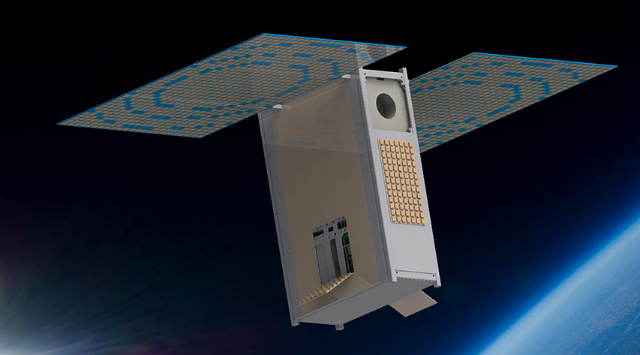From stargazer to space entrepreneur
Growing up in rural eastern Colorado, Dan Nevius, S.B. ’11, could see plenty of stars from his backyard. Gazing at those tiny points of light, he dreamed about the vastness of space and the thrill of exploring uncharted territory.
Now, he is preparing to embark on an entrepreneurial mission that will literally launch his startup company into outer space. Analytical Space, which he co-founded with fellow Harvard Business School MBA student Justin Oliveira about a year ago, will use laser-equipped in-orbit relays to help companies more efficiently retrieve data from their satellites.
Nevius, who concentrated in electrical engineering and computer science at the John A. Paulson School of Engineering and Applied Sciences, with a secondary concentration in astrophysics, shunned the more traditional path of working as an engineer for a major rocketry company.
“During my senior year, I talked to a lot of the engineers who worked at space companies, and most of them did very specialized work on one particular part of the rocket,” he said. “I didn’t want to do that. I wanted to be the guy who christens and launches the rockets. It became clear to me that I needed to be a space entrepreneur.”
As his career was gaining steam, the sun was setting on the space shuttle program. Nevius drew inspiration from scrappy startups that were clamoring to fill the vacuum left by NASA. After several internships in the field, and a job at asteroid mining company Planetary Resources, Nevius returned to Harvard to earn an MBA and work on his startup, which is currently housed in the iLab.
He developed the concept for Analytical Space through his experiences at Planetary Resources. At that firm, Nevius designed constellations of satellites that could conduct remote sensing of the Earth. He quickly realized that delivering data back to Earth was a major headache.
Many low-orbit remote sensing satellites circumnavigate the Earth about every 90 minutes, gathering massive amounts of information as they travel. However, they can only transmit data to Earth when they are within the line of a site of a radio dish on the ground.
“A satellite can only transmit data through radio for maybe 10 minutes or so before it has gone beyond the edge of the horizon,” Nevius explained. “These radio dishes are placed strategically to get the best coverage, but the planet is 70 percent water, so most of the time these satellites are over the ocean with nowhere to dump their data. They are limited by the physical constraints of the planet.”
Analytical Space seeks to solve that data backlog problem by using lasers to transmit information. The company’s orbital relays, each about the size of a shoebox, will gather data from customers’ satellites through radio and store it on board. When an Analytical Space relay passes an optical ground terminal it will transmit data using a laser, a method that is approximately 10 times faster than radio.

This rendering shows what an Analytical Space orbital relay might look like. (Image courtesy of Analytical Space.)
“The data comes in as a trickle from customers through radio and then we essentially shoot it down through a fire hose, increasing the data pipeline from the spacecraft down to the ground,” he explained. “In a sense, we are trying to act as a mobile hot spot in space to give these satellites more connectivity.”
Analytical Space satellites will also be able to pick up signals from remote devices on the Earth, and then transmit that information via laser to distant collection points. That service is designed for customers monitoring areas that are hard to connect through terrestrial infrastructure, such as offshore platforms or sprawling pastureland.
Nevius and Oliveira are fine-tuning the design of their small satellites, and hope to be ready for initial launch next winter. They will need about 20 satellites to cover the planet, but the firm will be able to provide less frequent data transmission services for its early customers even before the full fleet is in orbit.
Aside from the typical challenges of launching a startup, such as securing funding and creating a pricing model, they face additional hurdles due to the strict regulatory environment, which requires the company to obtain approvals from the Federal Aviation Administration and the Federal Communications Commission.
But despite the challenges and the apprehension that comes with innovating in a new space, Nevius is excited for a future full of possibilities.
“On an intellectual level, I really enjoy the problem solving aspect and figuring out how all the different pieces will fit together,” he said. “But even beyond the physical engineering, it is cool to be in a position where we can serve as a data backbone for other companies that are using this information to help people all over the world. We can play a hand in building the infrastructure that allows NASA or private companies to go out and explore the solar system.”
